The Book

I am the author of the textbook, The Music Business for Music Creators. Released by Routledge / Taylor & Francis in 2024, the book aims to educate and empower emerging music creators on the key business concepts that underpin how the business operates. With a focus on a simplified approach to understanding both the traditional and the modern aspects of the industry, the book also identifies income streams that enable music creators to turn professional. With a great deal of context using case studies, interviews and scenarios, the book is also highly suitable for a range of both music creation and music business courses across a range of global educational settings.

Buy the book – click here
The Music Business for Music Creators Chapter List
(full book available for purchase above)
Contents
Song and Recording Copyrights
Chapter 1 – Understanding Copyright
– What Is it?
– How To Protect Your Copyright
– How Long Does a Copyright Last?
Chapter 2 – What are Master Rights?
– Who Owns your Masters?
– The Benefits of Owning Master Rights
– What are Points?
Chapter 3 – Song Splits
– Songwriting in Bands
– Songwriting with Producers
– Differences in Cultures and Genres
– Translation
– Put It in Writing
Music Industry Structures and Roles
Chapter 4 – What is Music Publishing?
– What do Music Publishers do?
– Interview: Greig Watts, DWB Musi
– So, Music Publishing Isn’t Actually About Publishing Music?
– The Origins
– Types of Music Publishing Contracts
– Key terms of a Music Publishing Contract
– Considerations for Songwriters
Chapter 5 – The Role of a Record Company
– What Do Record Companies Do?
– Artist Option One: The major label route
– Artist Option Two: The indie label route
– Types of Record Deals
– Company Structures
– Roles within a Record Company
– Interview: Lorenzo Filippin
– Record Label Offshoots
Chapter 6 – Artist and Labels Services
– The Concept
– Case Study: Absolute Label Services
– Interview: Kate Hendry, Head of Label Operations, Absolute Label Services
Chapter 7 – What Do Artists Managers Do?
– Duties
– Types of Managers
– When Does a Music Creator Need a Manager?
– How To Find a Manager
– Interview: Denise Beighton, Upside UK
– What Kind of Commission Does a Manager Take?
– Interview: John Hart Music Management
– Do Managers Financially Invest in Artists?
– Experience or Passion?
– Network
– Preliminary Periods
– Double Interview: Sipho and Kieran Thompson
Chapter 8 – What Do Music Lawyers do?
– Key duties
– When Should a Music Creator Hire a Lawyer?
– What Deal Should a Creator Expect from a Lawyer?
Chapter 9- What Do Accountants Do?
– Typical Duties
– Additional Duties That are More Specific to a Music Business Accountant
Chapter 10- Understanding the Live Sector
– Promoters
– Booking Agents
– Festivals
– Interview: Andy Rea
– Live Streaming
– Tour managers
– Grass Roots Growth
Being a Recording Artist
Chapter 11- Artist Development: The Rarely Spoken Truths of Self Discovery
– Who and What Are You?
– Does the Creator Make the Same Music That Inspires Them?
– Interview: Karen Harding
– What Defines a Recording Artist?
– Interview: Laurence Hobbs, SAFO Music
Chapter 12 – Being in a Band
– Interband Agreements
– Interview: Gavin Monaghan
– Legal Structure of a Band
– The Transition into Becoming a Fulltime Band
– Interview: Chris Clark
– Becoming Members of Collection Societies
– Band Names and Trademarks
– Interview: Jonas Ekdahl
Chapter 13 – The Art of Negotiation
– Scenarios of Negotiation
– Why are Contracts So Hard to Read?
– Key Considerations for Recording Artists in Recording Contracts
– Key Considerations for Songwriters in Music Publishing Contracts
– Don’t Be Afraid of Contracts
Chapter 14- Rights Management and Collection Societies
– Collection Societies
– What Collectable Rights Exist?
– Collection Societies and Collection Management Organisations
Chapter 15 – Song and Recording Registration
– Registration Process
– Song and Recording Codes
– Catalogue Codes
– Additional PRO Specific Codes
Releasing Music
Chapter 16 – Releasing Music without a Record Company
– What Is the Reason For Wanting to Release Music?
– Campaign Structure and Philosophy
– Interview: Erik Nielsen, Wingnut Music
Chapter 17 – Ten Key Steps When Releasing Music
– Ten Steps
– Post Release Pitching
Chapter 18 – Writing a Press Release
– Then Ten Elements of a Press Release
– The Public Actions Vs The Real Actions of an Emerging Artist
Chapter 19 – Understanding Digital Distribution
– What Kind of Price Plan Works Best For Your Project?
– Delivery To Stores
– Social Media Delivery and Content IDs
– Aiding Discovery and Future Proofing Releases
– Playlist Pitching
– The Process of Waterfalling Singles
– Support Service
– Making Changes to Releases
– Code Generation
– Data Analysis
– Meta Tagging
– Additional Tools and Features
– Marketing Services
– Do You Pay Commission?
– Splitting Revenue with Co-Creators
– Sync Licensing Options
– Working with a Serviced Distributor
– Interview with Emily Jackson, Horus Music
Chapter 20 – Releasing Cover Songs and Remixes
Chapter 21 – Costing and Budgeting for Artists Releasing Music
– Recording Songs
– Distribution
– Artwork and Branding
– Social Media Marketing Spend
– Self-Created PR
– Pitching to Taste Makers
– Radio Exposure
– Video
– Does an Artist Need a Website?
Chapter 22- Understanding Growth on Streaming Platforms
– Systems of Recommendation
– Collaborative Filtering
– Content Based Filtering
– Contextual Factors
Chapter 23 – The Algorithmic Scaffold of Spotify and its Playlists
– The Six Fundamental Elements
– Feeding The Algorithm as a Consumer
– Playlist Categories
Chapter 24- Pitching For Playlists
– Pitching Methods
– Key Cultural and Stylistic Traits of a Song
– Key Things to Avoid When It Comes To Playlist Pitching
Chapter 25 – Sonic Virality: When the Listeners Speak
– The Key Performance Indicators for Growth on a Spotify Profile
– Old is the New, New
Chapter 26- Ten Tips for Gaining Growth on Audio Streaming Platforms
Chapter 27 – Sampling and Being Sampled: The Culture of Permission
-Sampling Recordings Owned by Rightsholders
-Incorporating Parts of Known Songs into Yours Without Using the Original Recording
-Sampling Sonic Artefacts for Sound Design
-Being Sampled by Others
An Exploration of Income Streams for Music Creators
Chapter 28 – Paths of Profit for Music Creators
– Licensing Unique Content in the Context of Songs Created by Others
– Sample Packs
– Beat Leasing and Licensing
– Same Libraries and Sampled Instruments
– Plugin Design and The Pre-set Marketplace
– Accapella Licensing and Topline Songwriting
– Collaboration
Chapter 29 – Working For Hire
– Your Offer
– A Tiered Level of Options
– Price Point
– Turn Around Time
– Rights
– Revisions
– Virtual Attendance or Video Assistance
– Building a Sense of Uniqueness
– Bio
– Showreel
– Genre Specialism
– It’s Not About You
– Seasonality
– Encouraging Reviews
– Etiquette
– Interview: Natalie Major
Chapter 30 – The Self-Recording Musician
– Interview: Misstiq
– Interview: Martin ‘Magic’ Johnson
Chapter 31 – The Sync Business
– The Essence of a Song
– Typical Sync Lead Examples
– Metadata in Sync
– Clearance
– Preparing Your Pitch
– How To Pitch for Sync Opportunities
– Interview: Bryan Hinkley
– Contractual Considerations
– Knowing What to Quote
– Blanket Licensing
Chapter 32 – Artist Merchandise
Interview: Tersha Willis, Terrible Group
Chapter 33- Funding Opportunities
Chapter 34 – A Guide to Building a Portfolio Career: Understanding the Gig Economy
-What is a Portfolio Career?
-Embracing a Portfolio Career
– Self Management and Responsibility
– What is the Gig Economy?
– Analogue Vs Digital
– How Do Creators Set up Remote Work Opportunities?
– Taking Time To Understand Each Other
– Working for the Music
– Identifying Your Niche
– Additional Skills
– Being Easy To Work With
– Key Areas of Skill Development
– Positives and Negatives of a Portfolio Career
– Suggestions for Getting Started
– Scenarios of Portfolio Career Professionals
Chapter 35 – Reaching out to Music Industry Professionals
– Speaking Different Languages
– The Codes and Modes of Communication
– Beware of Premature Introductions
– The Email Pitch to a record Company
– The Email Pitch to a Music Publisher
– The Email Pitch to a Sync Agent
– Lazy Language and General Gaps
– Considerations for Artist Pitching Themselves to Record Companies
Chapter 36 – Songwriters Pitching Songs to Recording Artists
– Suitability
– Research
– Interview: Ricky Hanley
– Pitching
– Who Else Can Songs be Pitched To?
– Interview: David Stark
– Network
– The Mysteries of Ghostwriting
Chapter 37 – Expected Standards of Song Presentation
-Demo Recordings
-Pitching to Record Companies
-Pitching to Music Publishers
-Pitching to Artist Managers
-Pitching to Songwriter and Producer Managers
-Pitching to Sync Agents
-Pitching to Producers
-Pitching to DJs
-Outsourcing
-Loops, Samples and Plugins
-Mixing
-Mastering
-Stem Flexibility and Delivery
38 – Production Music and Media Composers
– What Is It?
– Who is Production Music Useful To?
– Rights and Usage
– How Do Creators Get Paid?
– Modern Advancements
– Interview with Dr Paul Rogers
– What Kind of Creators Tend to be Useful Media Composers?
39 – The Importance of Metadata
– The Key Components of Metadata
– Metadata in Context
The Future of The Business
Chapter 40- The Global Marketplace
– The Top Ten Music Markets in the World
– International Markets Expand as Homegrown Talent Develops
– Interview: Rudd Budze, Universal Music Latvia
– Sample Driven Electronic Music Genres
Chapter 41 – Artificial Intelligence in Creativity and Analytics
– The Role of Artificial Intelligence in Creativity
– Ethically Sourced Data for AI Usage
– Interview: Alex Bestall
– Artificial Intelligence in A&R
Chapter 42 – Mental Health Awareness: A Creators’ Understanding of Self-Care
– Interview: Dr Adam Ficek
– Social Media: A Marketing Monster or a Toxic Tirade of Bragging Rights?
– What is the Music Industry Doing to Offer Greater Wellbeing Support to Creators?
– A Creator’s Awareness of Self Care
Chapter 43 – Beyond The Horizon: Exploring the Future of the Music Business
– The Boom of Artist Audiobooks
– A Reconstruction of Values in an Artist-Centred Ecosystem
– Interview: Tilly Wellard
– The Extension of Song Copyrights
– What Could Happen with NFTs
– The Evolution of The Song
– Non-Traditional Growth in Sync Licensing
– Breakout Stars That Learn to Leverage Their Network
– The Development of Live Streamed Events
– The Evolution of Audio Streaming Economics
Chapter 44 – Your Future
– Good Things Come to Those Who Wait
– Interview – Kevin Charge

